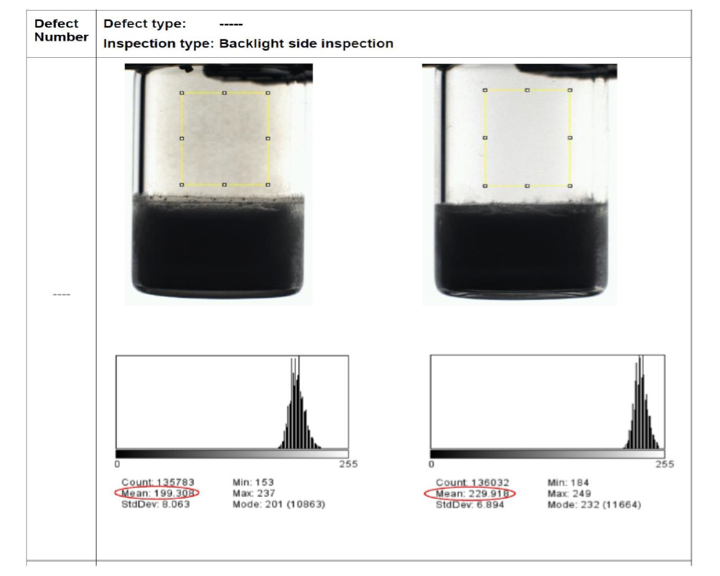Optimization Strategies For Automated Visual Inspection Of Lyophilized Vials

Table of Contents
Image Acquisition Optimization
High-quality images are fundamental to accurate defect detection in automated visual inspection. Optimizing image acquisition involves careful consideration of lighting techniques and camera selection.
Lighting Techniques
Proper lighting is crucial for detecting subtle defects in lyophilized vials. Different lighting techniques can highlight specific imperfections, ensuring comprehensive coverage.
- Utilize diffused lighting: Diffused lighting minimizes glare and harsh shadows, allowing for clearer visualization of surface details. This is particularly important for detecting cracks or particulate matter.
- Experiment with coaxial lighting: Coaxial lighting, where the light source is aligned with the camera axis, enhances surface detail visibility by reducing reflections. This technique is effective for identifying subtle variations in surface texture.
- Consider using structured lighting: Structured lighting projects patterns onto the vial surface, allowing for three-dimensional analysis and improved detection of defects like cracks or delamination. This offers advanced defect detection capabilities.
- Implement multiple light sources: Combining different lighting techniques (e.g., diffused and coaxial) provides comprehensive illumination and enhances the detection of a broader range of defects.
Camera Selection and Calibration
The camera system is a critical component of the automated visual inspection system. Careful camera selection and regular calibration are crucial for optimal performance.
- High-resolution cameras: High-resolution cameras provide superior detail, allowing for the detection of even the smallest imperfections in lyophilized vials. Resolution directly impacts the ability to identify critical defects.
- Camera calibration: Accurate camera calibration ensures consistent measurements and minimizes geometric distortions in the images. This is essential for reliable defect detection and accurate size measurements.
- Color cameras: Color cameras offer enhanced defect identification by enabling the detection of color variations, which might indicate contamination or other defects not easily visible with monochrome cameras.
- Regular calibration: Regular recalibration is vital to maintain accuracy and consistency over time. Environmental factors and equipment wear can impact camera performance.
Algorithm Optimization for Defect Detection
The algorithms used for defect detection are central to the system's accuracy and efficiency. Careful selection, training, and parameter tuning are critical.
Algorithm Selection and Training
Different algorithms offer varying capabilities in detecting specific defects. Choosing the right algorithm and training it effectively are crucial steps.
- Machine learning algorithms: Machine learning algorithms, like Support Vector Machines (SVMs) or Random Forests, can be trained to recognize specific defects using labeled datasets of images. This allows for customization to the specific types of defects commonly encountered.
- Deep learning models: Convolutional Neural Networks (CNNs) are a type of deep learning model particularly effective at identifying complex patterns and subtle variations in images, making them ideal for detecting complex defects in lyophilized vials.
- Algorithm validation: Thorough validation using a representative dataset is crucial to ensure the algorithm's accuracy and reliability. This involves testing the algorithm's performance on a separate dataset not used for training.
- Continuous training: Continuous training with new data improves algorithm accuracy over time, adapting to changing conditions and emerging defect types.
Parameter Tuning
Fine-tuning algorithm parameters is essential for optimizing the balance between sensitivity and specificity.
- Adjusting thresholds: Carefully adjusting thresholds for defect size, shape, and other characteristics minimizes both false positives (incorrectly identifying non-defects) and false negatives (missing actual defects).
- Optimizing contrast: Optimizing contrast settings enhances defect visibility and improves the algorithm's ability to differentiate between defects and normal variations.
- Balancing sensitivity and specificity: Finding the optimal balance between sensitivity (detecting all defects) and specificity (avoiding false positives) is key to minimizing errors and improving efficiency.
- Statistical Process Control (SPC): Implementing SPC techniques allows continuous monitoring of the algorithm's performance, enabling prompt identification and correction of any drift in accuracy.
System Integration and Workflow Optimization
Efficient system integration and workflow optimization are critical for maximizing throughput and minimizing downtime.
Automated Handling and Conveying
Automated handling and conveying systems are crucial for efficient vial processing and consistent inspection.
- Robotic systems: Robotic systems provide automated vial handling and placement, ensuring consistent presentation to the inspection system and minimizing the risk of damage.
- Conveyor design: A well-designed conveyor system ensures smooth, damage-free transport of vials through the inspection process, minimizing misalignments and ensuring consistent image acquisition.
- Throughput monitoring: Monitoring system performance helps identify bottlenecks and optimize throughput, ensuring the system operates at maximum efficiency.
- Regular maintenance: Regular maintenance of the handling and conveying system is essential for maintaining reliability and preventing downtime.
Data Management and Reporting
Effective data management is vital for quality control, regulatory compliance, and continuous improvement.
- Data management system: A robust data management system is needed to store and manage the large volumes of inspection data generated by the automated system. This should include secure storage and easy retrieval capabilities.
- Comprehensive reporting: The system should generate comprehensive reports detailing inspection results, identifying defects, and tracking overall system performance. These reports are crucial for regulatory compliance.
- Data analytics: Utilizing data analytics allows for the identification of trends and patterns in defect occurrence, enabling proactive improvements to the manufacturing process.
- System integration: Integrating the automated visual inspection system with existing quality control and manufacturing execution systems (MES) streamlines workflows and improves data traceability.
Conclusion
Optimizing automated visual inspection systems for lyophilized vials requires a holistic approach. By carefully considering lighting techniques, camera selection, algorithm training, parameter tuning, and workflow optimization, pharmaceutical manufacturers can significantly enhance the accuracy, efficiency, and reliability of their quality control processes. Implementing these optimization strategies for automated visual inspection of lyophilized vials is crucial for maintaining product quality, reducing waste, and meeting stringent regulatory requirements. Investing in these strategies leads to improved product quality, reduced waste, and enhanced overall efficiency. Contact us today to discuss how to improve your automated visual inspection process and explore solutions tailored to your specific needs.

Featured Posts
-
 Adio Thomas Mueller Ultimul Meci Acasa Pentru Legenda Bayern
May 11, 2025
Adio Thomas Mueller Ultimul Meci Acasa Pentru Legenda Bayern
May 11, 2025 -
 Visita Familiar De Boris Johnson A Texas Termina Con Ataque De Avestruz
May 11, 2025
Visita Familiar De Boris Johnson A Texas Termina Con Ataque De Avestruz
May 11, 2025 -
 Indigenous Capital Group And Ottawa Forge Groundbreaking 10 Year Agreement
May 11, 2025
Indigenous Capital Group And Ottawa Forge Groundbreaking 10 Year Agreement
May 11, 2025 -
 Will Sylvester Stallone Have A Larger Role In Jason Stathams Next Film
May 11, 2025
Will Sylvester Stallone Have A Larger Role In Jason Stathams Next Film
May 11, 2025 -
 Ufc 315 Main Card Recap Muhammad Vs Della Maddalena And More
May 11, 2025
Ufc 315 Main Card Recap Muhammad Vs Della Maddalena And More
May 11, 2025
